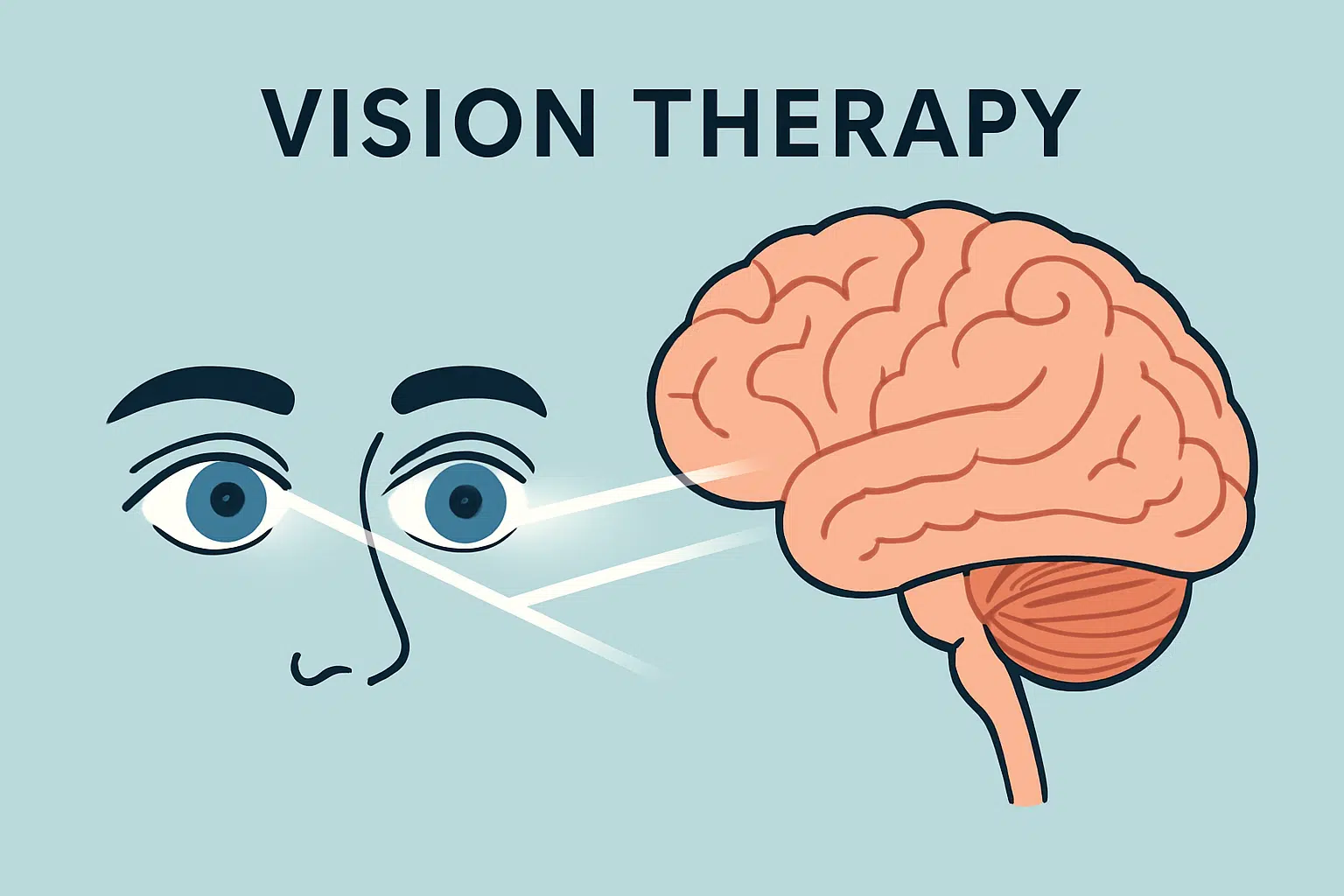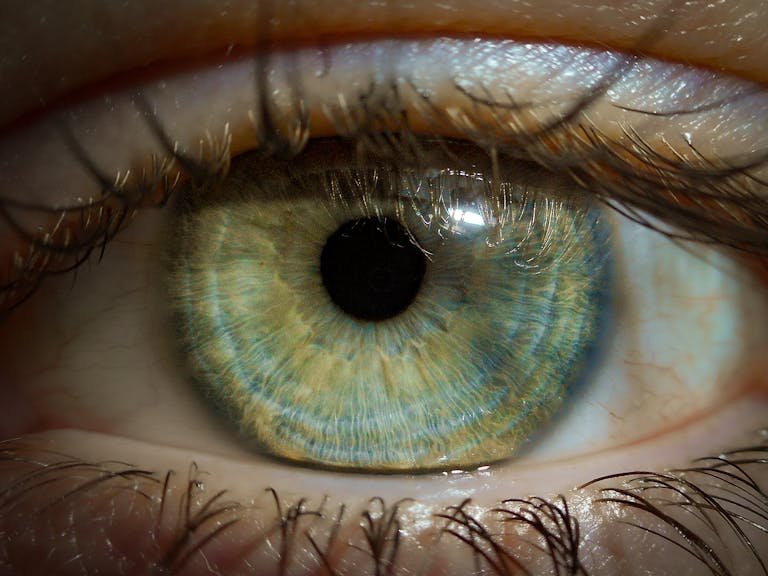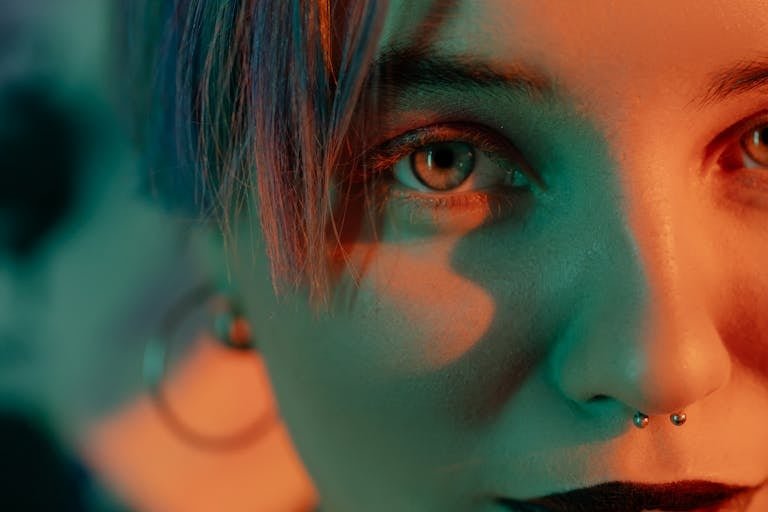Vision Therapy Treatment Methods
Vision therapy represents a personified therapeutic process that demonstrates great effectiveness to improve eye-brain interactions. This guide has been specifically created for people experiencing issues with lazy eye, together with eye strain, as well as double vision and learning-related vision problems.
In this blog, we’ll explore what vision therapy is, how it works for adults, the types of conditions it treats, and what you can realistically expect from the process.
What is Vision Therapy?
Vision therapy is a customized program of visual activities designed to correct certain vision problems and improve visual skills. Vision therapy focuses on treating problems with eye coordination and eye movement, as well as focusing skills and visual processing needs, instead of the way contact lenses or glasses work to correct focusing.
The treatment consists of medical guidance for eye exercises and visual activities, which an optometrist builds according to patient-specific requirements. The treatment provides the equivalent benefits as physical therapy does for the eyes and the brain.
Types of Vision Therapy
1. Orthoptic Vision Therapy
Orthoptic therapy exists to enhance the effectiveness of muscles that steer eye movements. The medical field employs this treatment primarily for addressing convergence insufficiency alongside strabismus cases.

Steps Involved:
- Initial Assessment: Eye alignment assessment along with movement evaluation is part of the initial evaluation carried out by your optometrist.
- Pencil Push-Ups: Stand while holding a pencil in front of your face at arm’s length before moving it toward your nose, maintaining steady eye vision focus.
- Brock String Exercises: Exercises require a string equipped with colored beads to teach the eyes proper tandem actions.
- Prism Therapy: Special lenses act as light-modifying tools that enhance eye alignment during Prism Therapy.
- Barrel Cards: Barrel Cards serve as an exercise tool to develop the convergence and divergence functions of your eyes.
Goals:
- Strengthen extraocular muscles
- Improve coordination between both eyes
2. Behavioral Vision Therapy
The method covers the brain’s interpretation of visual data in addition to visual processing input.
Steps Involved:
- Visual Skills Testing: Your optometrist conducts tests that evaluate your visual perception, together with visual memory and hand-eye coordination elements.
- Spatial Awareness Training: Training includes activities that involve bargaining through obstacle courses to enhance awareness levels.
- Peripheral Vision Activities: Training in peripheral vision occurs through the use of lights or objects set off to the side of your direct gaze.
- Cognitive Integration: You’ll work on tasks that combine visual input with thinking skills, like solving puzzles or identifying patterns.
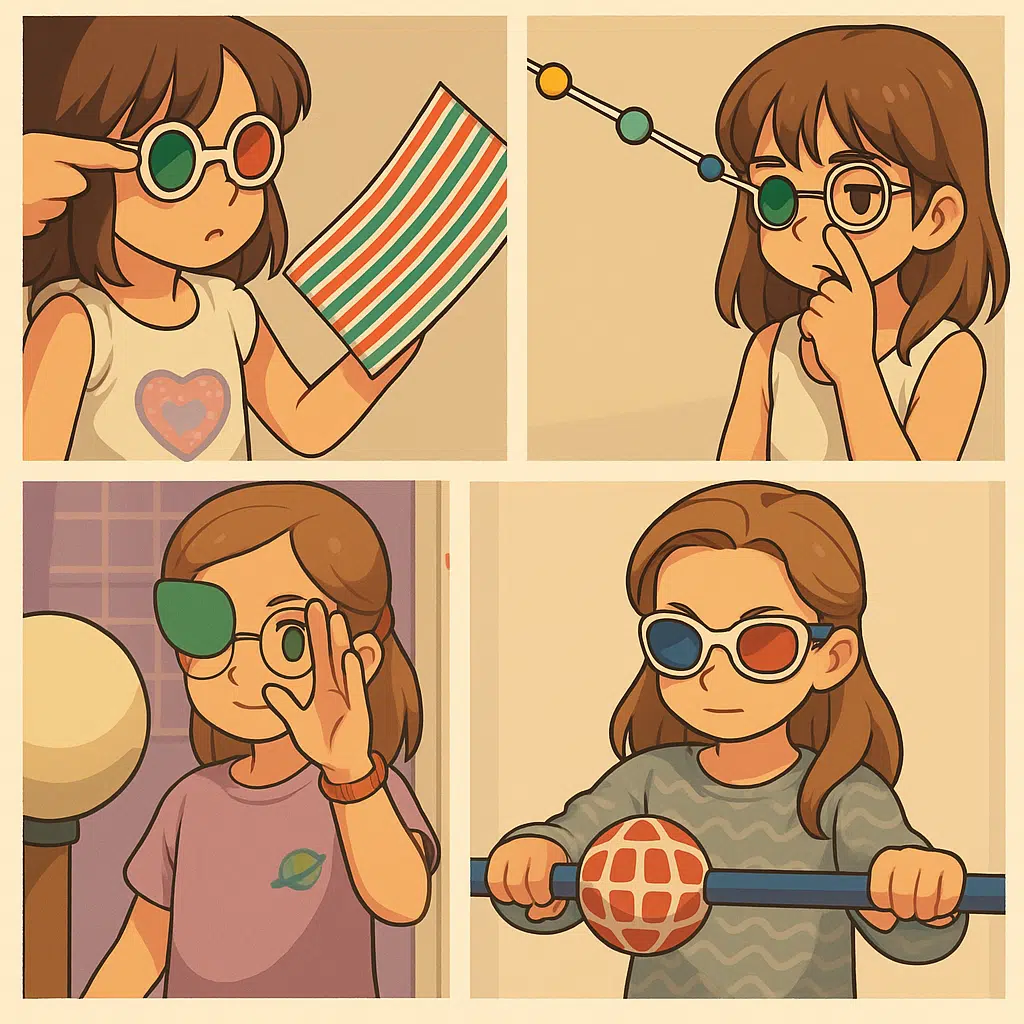
Goals:
- Improve visual cognition
- Enhance eye-brain connection
- Boost learning and comprehension
3. Computer-Based Vision Therapy
This therapy program merges existing physical exercises with digital interfaces, which can be executed either in treatment clinics or your personal residence.
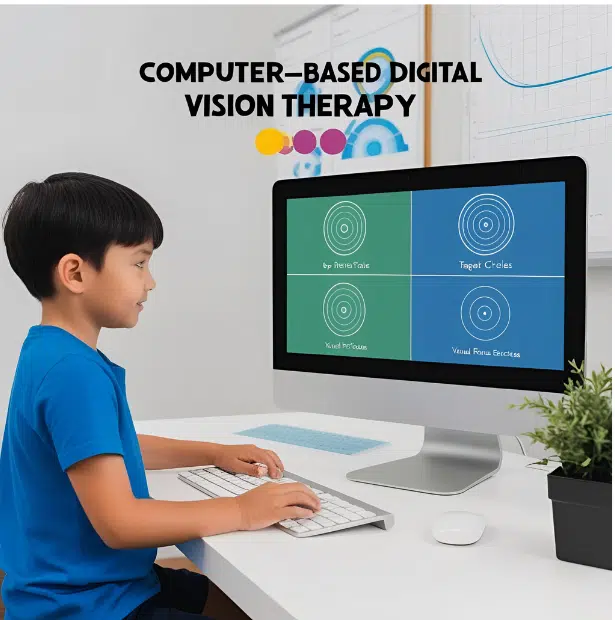
Steps Involved:
- Digital Diagnostic Tools: Digital diagnostic software uses programs to evaluate your eye performance when performing different tasks.
- Interactive Games: Games you will engage in therapeutic activities which sharpen your focus ability and tracking skills and enhance eye teaming.
- 3D Training Modules: These simulate real-life tasks to improve depth perception and binocular vision.
- Progress Reports: The platform records patient development toward improved vision, which controls task complexity.
Goals:
- Increase visual stamina
- Provide engaging therapy experiences
- Make vision therapy more accessible
4. In-Office Vision Therapy
The therapist receives professional supervision while using exercises that target your particular needs.
Steps Involved:
- Custom Evaluation: A complete vision test will evaluate specific problems or conditions.
- Equipment-Based Exercises: Tools like balance boards, vision charts, and computerized programs are used.
- Real-Time Feedback: Your therapist provides guidance and immediate corrections.
- Skill Building: The program includes tracking training together with convergence focusing and accommodation practice and visual-motor skills improvement.
Goals:
- Deliver high-impact therapy
- Ensure correct technique and progress
5. Home-Based Vision Therapy
Best for maintaining progress between in-office sessions or for those with milder conditions.
Steps Involved:
- Home Program Design: Your therapist prepares activities for you after evaluating your treatment outcomes in Home Program Design.
- Daily Practice: Every day includes the performance of activities such as stringing beads in addition to flashcard recognition exercises and mirror tracing activities.
- Parental Involvement (for Children): Children’s parents frequently receive requests to track their progress through supervision duties.
- Periodic Check-ins: Patients must visit the clinic frequently for both reporting their advancement and adapting their home therapy designs.
Goals:
- Reinforce clinic-based therapy
- Build consistency and habit
- Make therapy more convenient
How Long Does Vision Therapy Take?
The duration of vision therapy treatment depends on multiple factors, which include medical condition type and patient age, with added consideration of treatment consistency.
A typical program might last:
- 3 to 9 months for children
- 4 to 12 months for adults, especially if there’s a history of trauma or ingrained visual habits
Each patient receives one or two sessions each week for a time frame of 45–60 minutes while completing daily home exercises between appointments.
In-Office vs. Home-Based Therapy
The therapy regimen of many optometrists includes structured sessions in their practices and independent home exercises as a part of treatment.
Here’s how they compare:
| Aspect | In-Office Therapy | Home-Based Therapy |
|---|---|---|
| Supervision | Full (guided by optometrist) | Self-guided, often computer-based |
| Tools and Equipment | Professional and specialized | More basic or digital |
| Flexibility | Less, requires appointments | High, can be done anytime |
| Customization | High | Moderate |
| Cost | Higher | Lower |
Why Do Adults Need Vision Therapy?
The lives of numerous adults deteriorate when they continue to live with undiscovered vision problems. The following list shows reasons why adults turn to vision therapy services:
1. Digital Eye Strain
Long computer, phone, and tablet use triggers Computer Vision Syndrome (CVS) that results in different symptoms, including:
- Eye fatigue
- Blurred vision
- Headaches
- Dry eyes
2. Binocular Vision Dysfunction
Swimming eyes that cannot coordinate properly create several complications that include the following symptoms:
- Double vision
- Eye strain
- Difficulty with depth perception
3. Post-Concussion Vision Issues
Brain trauma or concussion typically results in visual challenges for all affected individuals. Vision therapy can help treat:
- Light sensitivity
- Blurred vision
- Difficulty focusing
- Motion sensitivity
4. Strabismus (Eye Turn) and Amblyopia (Lazy Eye)
Adults alongside children develop these vision conditions, which benefit from receiving therapy treatment.
5. Reading and Learning Challenges
The ability to track vision and focus impacts reading rates and comprehension levels in the reading material of adults in academic or professional work positions.
Read Also: Yellow Eyes Disease: Causes, Symptoms & Urgent Care
What Does a Vision Therapy Program Look Like?
The implementation of vision therapy varies by person but follows a standard procedure that consists of:
1. Comprehensive Eye Exam
A specialist optometrist conducting functional vision assessments checks the following three areas:
- Eye teaming
- Eye movement
- Depth perception
- Visual memory and processing
2. Customized Exercise Plan
You may be given activities to:
- Improve tracking
- Build convergence (bringing eyes together)
- Strengthen accommodation (focusing near to far)
- Enhance eye-hand coordination
3. Therapy Sessions
Patients perform treatment sessions weekly or biweekly in the office and practice their exercises at home during the intervals. Tools might include:
- Prisms
- Lenses
- Filters
- Computer-based vision games
- Balance boards
- Tracking charts
4. Duration
The duration of most programs ranges from 3 to 9 months based on both patient dedication and condition severity.
Benefits of Vision Therapy for Adults
- Reduced eye fatigue and headaches
- Better focus and concentration
- Improved reading and learning abilities
- Enhanced depth perception and coordination
- Easier recovery from concussion or TBI
- Decreased double vision and dizziness
Why Adults Need Vision Therapy
1. We Never Stop Using Our Eyes
Adults frequently face demanding visual concentration requirements when doing work at computers and while driving, together with their regular routine that includes both reading and multitasking.
Insufficient visual system efficiency produces several problems which include:
- Eye strain
- Headaches
- Double or blurred vision
- Difficulty with concentration
- Motion sickness
These symptoms are more than annoying—they’re signals that your visual system is struggling.
2. Vision Problems Don’t Disappear with Age
Common childhood vision conditions, including convergence insufficiency and strabismus, together with amblyopia, do not typically vanish on their own as people grow older. Some vision problems exist among adults who do not receive proper diagnosis or get appropriate medical treatment.
3. Brain Injuries & Concussions
Post-traumatic brain injury victims suffer from vision complications after sustaining brain trauma in situations such as motor vehicle accidents, falls, or sports-related collisions and stroke incidents. Neuro-optometric rehabilitation benefits significantly from vision therapy since it assists patients in reestablishing their coordination and balance abilities.
Benefits of Vision Therapy for Adults
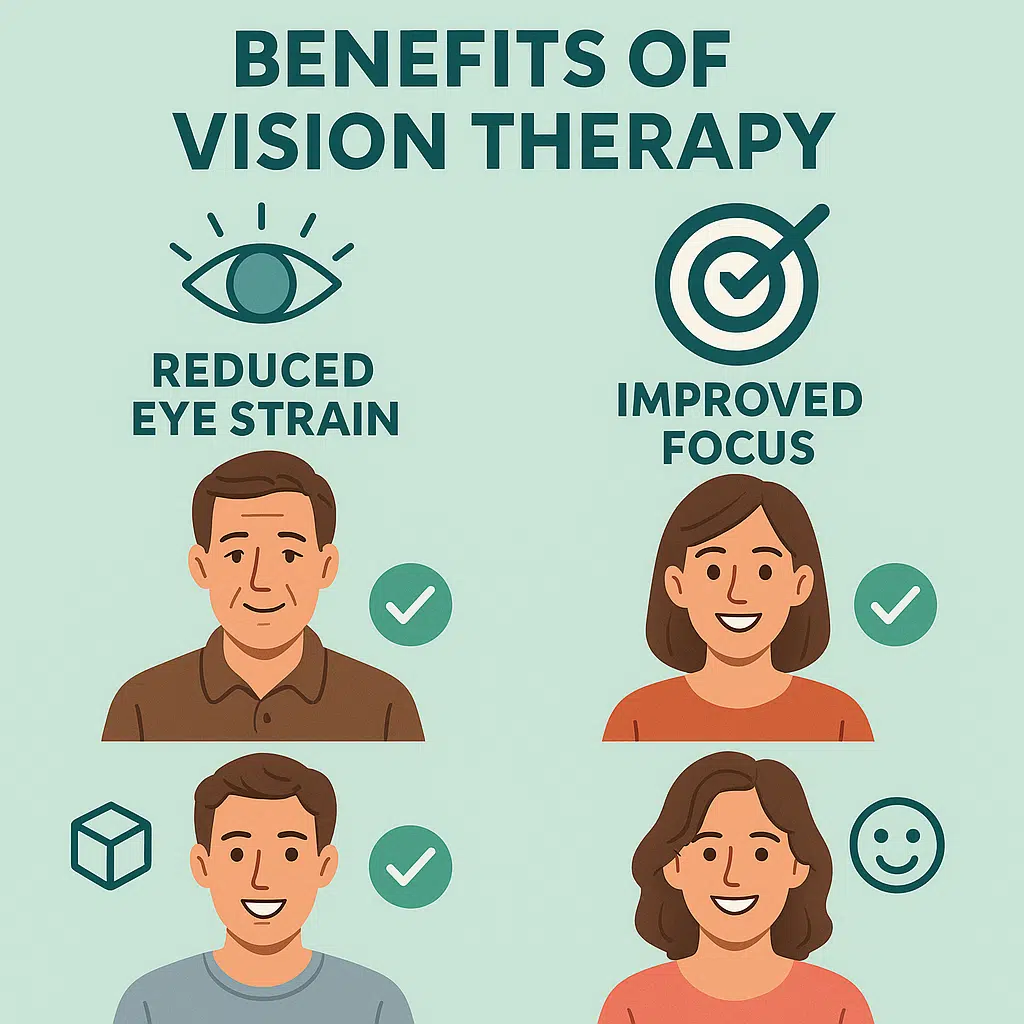
1. Reduces Eye Strain and Fatigue
Especially important for those working long hours on screens. The treatment leads to reduced headaches as well as improved concentration duration.
2. Improves Depth Perception
People who drive along with athletic players and those who must navigate busy areas reap significant benefits from this therapy.
3. Restores Reading and Learning Comfort
Reading tasks transform from difficult to easier. Your ability to focus enhances while words stay steady within their lines.
4. Enhances Work Performance
When visual comfort improves, productivity often follows. People feel less drained by the end of the day.
5. Improves Self-Confidence
Vision challenges cause both performance difficulties and social withdrawal among those who experience them. After vision therapy, patients recover their sight as well as their self-assurance.
Tips for Adults Considering Vision Therapy
- Find a Qualified Provider
Optometrists who hold COVD (Fellowship) certification or work at therapy centers are suitable choices for consultation. - Ask for a Visual Skills Evaluation
This evaluation provides greater detail than regular eyesight exams do. Your visual system operation becomes easily recognizable through this evaluation. - Commit to the Process
Therapy takes effort. Set reminders, be consistent with home exercises, and track your symptoms over time. - Involve Family or Friends
Having either emotional or physical support with practice from another person will significantly boost your motivation rates. - Journal Your Progress
Monitoring all types of improvements will create inner motivation as you move through the therapeutic journey.
Read Also: LASIK Eye Surgery Cost in Top USA Hospitals – Compare Now!
Final Thoughts
Absolutely. Vision therapy transforms the lives of numerous adults. The process requires considerable dedication but brings legitimate benefits along the way, although it takes time. The combination of vision therapy offers an important solution to individuals facing excessive tiredness or healing from injuries, or anyone desiring better visual performance with greater control.

